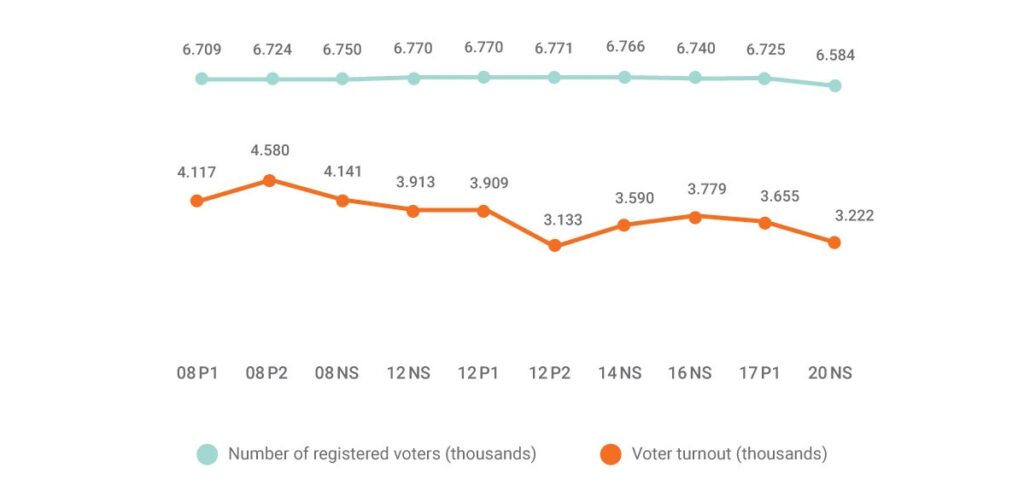The period between 2008 and 2020 can be divided into two phases. In the first phase (2008-2014), the elections took place in a relatively stable environment, and in the second (2014-2020) the situation deteriorated and discussions on equal election conditions became more frequent. The formal rules regulating the elections have not changed much during this time. The key change is the sharp decline in the quality of election conditions since 2014. In the second phase, the ruling parties gained such an advantage that the elections essentially lost their competitive character. In turn, the participation of both individual parties and voters in the elections decreased. While the role of elections in ensuring the representation of different political options in parliament diminished, formal changes that encouraged better descriptive representation of different groups were happening.
The electoral system, the broader institutional framework that shapes the way votes are transformed into mandates, has been relatively static, with few minor changes toward greater gender and national minority representation. However, at the end of the analyzed period, there was a decrease in the electoral threshold from 5% to 3% and an increase in the share of candidates of the underrepresented sex to 40%, immediately before the elections, contrary to established international practice.
The level of proportionality of the electoral system was generally satisfactory and stable, although crossing the 5% electoral threshold in the conditions of party domination after 2014 is becoming an increasing obstacle for political actors. In the critical period 2012-2016 frequent elections led to an intense, almost uninterrupted, campaign and since 2014, elections have gradually lost their competitive character. The trend of pluralism disappearing from the main representative body culminates in 2020 after a boycott of elections by the majority of the opposition.
Within the framework of electoral participation, we can observe two negative trends: “departyzation” of electoral lists and reduction of voter turnout. Restrictive conditions for the registration of political parties, an inflexible electoral system and the pronounced dominance of the ruling parties led to an increase in the number of coalition lists and groups of citizens, to the detriment of independent lists of political parties. Voter turnout ranged from extremely high at the beginning of the period (68% in the second round of the 2008 presidential election) to below half in the later stages (48% in the 2020 parliamentary elections).

Better representation of certain social segments of voters is the only positive change in this period. However, while the descriptive representation of women and national minorities in parliament grew, this was no guarantee that the position of these social groups would be improved. The drastic change in the generational structure of the parliament comes after the 2020 elections, when, for the first time, the generation of millennials in the parliament is more represented in relation to the estimated structure of voters.
Although weaknesses were present in the first phase, in the second phase, after 2014, there is a noticeable decline in the quality of the election process, in relation to the principles and standards to which the Serbian authorities are obligated to comply with domestic and international norms. The key factor that enabled this deterioration is the passivation of the election administration, regulatory and control bodies (such as REM or the Agency for the Prevention of Corruption).
The absence of a controlling role of independent institutions, with a politically biased election administration, and in a media environment that has already deteriorated, has created conditions for unhindered domination of ruling parties. This advantage is shown through the abuse of public resources, smear campaigns against political opponents that go unsanctioned and the development of clientelistic relationships with voters.
Overall assessment of the elections in the 2008-2020 period indicates a complex process that lasted more than a decade – which led to worsening electoral conditions, loss of the competitive character of elections, and lower electoral participation. Gradually, Serbia became a hybrid regime in which formal democratic institutions exist and represent a way of gaining and maintaining political power, but the ruling parties abuse them and gain multiple advantages in elections.
In order for the elections to become a process that improves the quality of democracy in Serbia, it is necessary to make efforts to improve several key areas. These are, above all: the role of the election administration, the functioning of independent bodies, the work of professional media, as well as changes in the rules and electoral system in the direction of encouraging participation in elections and a more direct relationship between voters and elected representatives.
